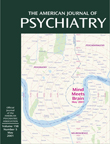Mirtazapine for Neuroleptic-Induced Akathisia
To the Editor: The agents currently available for the treatment of neuroleptic-induced akathisia (beta blockers, anticholinergics, and benzodiazepines) show only a modest treatment efficacy, and a substantial proportion of patients fail to respond to treatment. Recent findings of a low rate of neuroleptic-induced akathisia with the use of novel atypical antipsychotics, which have a greater serotonin type 2 (5-HT2) antagonism than dopamine D2 receptor blockade, suggest that the serotoninergic system may play a role in the pathophysiology of neuroleptic-induced akathisia (1). Consistent with this assumption is the antiakathitic activity of compounds with marked 5-HT2A/2C antagonism (ritanserin, cyproheptatide, and mianserin) (1). Mirtazapine is a tetracyclic antidepressant with structural and pharmacological similarities to mianserin (2). We explored the putative antiakathitic activity of short-term mirtazapine administration in a patient with acute neuroleptic-induced akathisia.
Mr. A was a 28-year-old unmarried man who came in for treatment after a 3-month history of persecutory delusions, auditory hallucinations, and bizarre behavior. He had no previous or family history of psychiatric illness or drug abuse. The results of a neurological evaluation, EEG, routine blood and urine tests, serum electrolyte measurements, and urea, liver, and thyroid function tests were within normal limits. A DSM-IV diagnosis of schizophreniform disorder was established, and treatment with haloperidol, 10 mg/day, was initiated. Four days later, Mr. A complained of leg restlessness, an inability to sit still, and a constant urge to move. His global score on the Barnes Akathisia Scale was 4 (“marked akathisia”). Administration of biperiden (4 mg b.i.d. for 5 days) with the subsequent addition of diazepam (10 mg/day for 3 days) had no effect on the severity of his neuroleptic-induced akathisia.
Mr. A consented to the addition of mirtazapine (15 mg at 8:00 a.m. for 5 days). Substantial relief of the subjective component of the akathisia, accompanied by a disappearance of the akathitic movements, was noted on the second day of mirtazapine treatment. Mr. A’s score on the Barnes Akathisia Scale dropped to 1. Discontinuation of mirtazapine on the fifth day led to a partial recurrence of the akathisia (Barnes Akathisia Scale score: 3), but a rechallenge (for 7 days) completely ameliorated his symptoms (Barnes Akathisia Scale score: 0). Mild transient sedation was the only side effect.
Mirtazapine is a potent antagonist of central α2 auto- and heteroadrenergic presynaptic receptors, as well as an antagonist of 5-HT2A/2C, 5-HT3, and histaminergic H1 postsynaptic receptors (2). The 5-HT3 receptor antagonism appears to be irrelevant to the antiakathitic action of compounds used to treat neuroleptic-induced akathisia (3). It seems likely that it is the marked 5-HT2A/2C receptor antagonism that accounts for the beneficial effect of mirtazapine in neuroleptic-induced akathisia. The time needed to maintain the effect is as yet unclear. If our findings are confirmed in placebo-controlled studies, mirtazapine may serve as an additional option in the 5-HT-based pharmacotherapy for acute neuroleptic-induced akathisia.
1. Poyurovsky M, Shargorodsky M, Fuchs C, Schneidman M, Weizman A: Treatment of neuroleptic-induced akathisia with the 5-HT2 antagonist mianserin. Br J Psychiatry 1999; 174:234–242Crossref, Google Scholar
2. de Boer T: The pharmacological profile of mirtazapine. J Clin Psychiatry 1996; 57(suppl 4):19–25Google Scholar
3. Poyurovsky M, Weizman A: Lack of efficacy of the 5-HT3 antagonist granisetron in the treatment of acute neuroleptic-induced akathisia. Int Clin Psychopharmacol 1999; 14:357–360Crossref, Medline, Google Scholar



